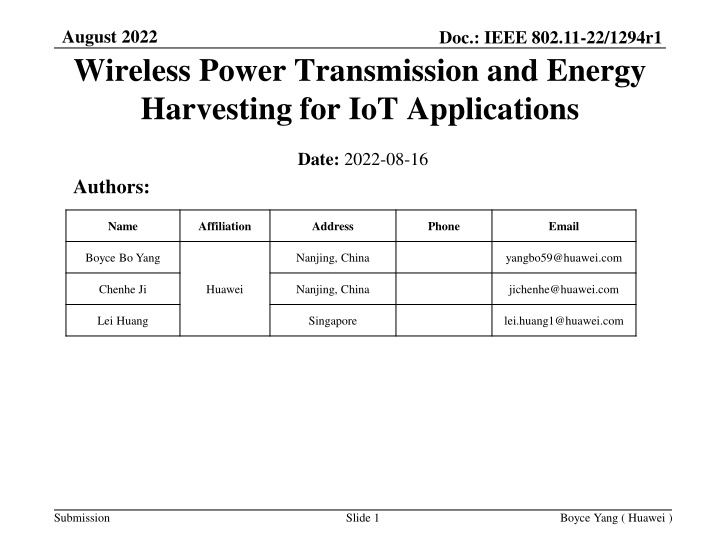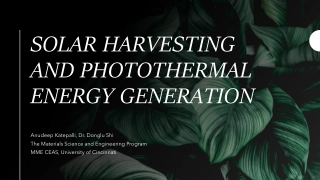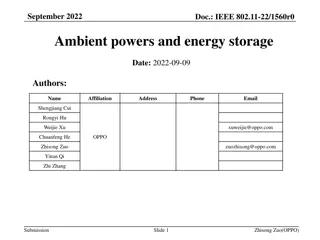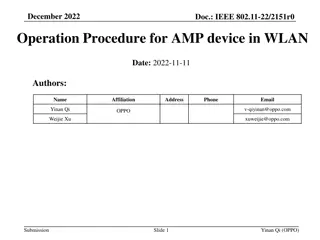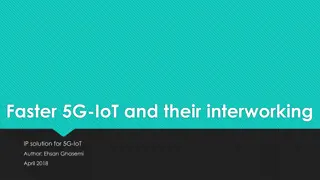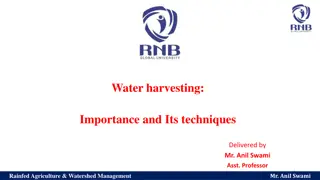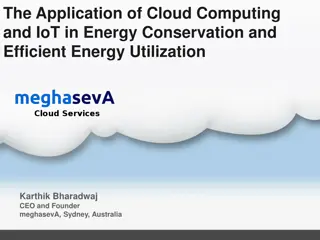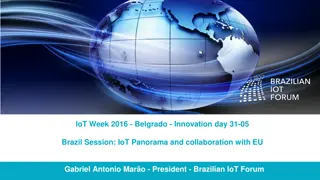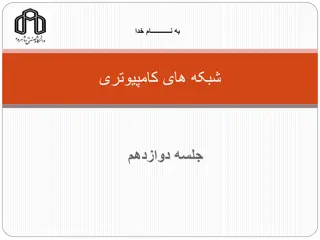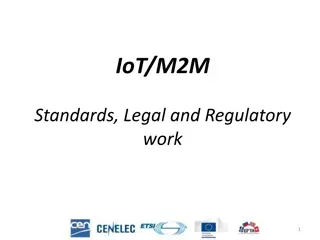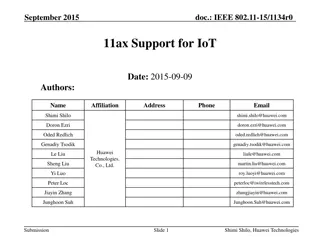Wireless Power Transmission and Energy Harvesting for IoT Applications
This document explores challenges and solutions in ambient energy harvesting for IoT devices, focusing on the instability of ambient power and the low energy harvested from RF signals. It discusses the importance of dedicated power signals and energy sources to improve efficiency and practicality. The limitations of RF power transfer and the preference for IoT devices with power storage are highlighted.
Download Presentation

Please find below an Image/Link to download the presentation.
The content on the website is provided AS IS for your information and personal use only. It may not be sold, licensed, or shared on other websites without obtaining consent from the author.If you encounter any issues during the download, it is possible that the publisher has removed the file from their server.
You are allowed to download the files provided on this website for personal or commercial use, subject to the condition that they are used lawfully. All files are the property of their respective owners.
The content on the website is provided AS IS for your information and personal use only. It may not be sold, licensed, or shared on other websites without obtaining consent from the author.
E N D
Presentation Transcript
August 2022 Doc.: IEEE 802.11-22/1294r1 Wireless Power Transmission and Energy Harvesting for IoT Applications Date: 2022-08-16 Authors: Name Affiliation Address Phone Email Boyce Bo Yang Nanjing, China yangbo59@huawei.com Chenhe Ji Huawei Nanjing, China jichenhe@huawei.com Lei Huang Singapore lei.huang1@huawei.com Submission Slide 1 Boyce Yang ( Huawei )
August 2022 Doc.: IEEE 802.11-22/1294r1 Abstract We discuss two challenges in ambient energy harvesting Challenge 1: Ambient power is unstable Challenge 2: The energy that can be harvested from RF signals is low The reasonable scenarios considering these challenges are also discussed. Submission Slide 2 Boyce Yang ( Huawei )
August 2022 Doc.: IEEE 802.11-22/1294r1 Challenge 1: Ambient power is unstable To harvest energy from radio waves, the RSS should be higher than a threshold, e.g. -15dBm. The threshold is largely decided by the forward voltage of diodes which are crucial components in the rectifier. Far-field RF energy is weak. IoT devices can only harvest energy from Wi-Fi signals transmitted by nearby transmitters. Unfortunately, Many IoT devices are far away from Wi-Fi transmitters. Wi-Fi signals of data communication are not continuous. Channel Utilization (CU) in a typical office, is around 10% in 2.4GHz channels, where ?? = ???? ????/????????????. Note that CCA-Busy has a much lower threshold (i.e. -82dBm) . Recall that the required RSSI of energy harvesters are much higher, e.g. -15dBm. This rarely happens in a natural WLAN environment. Submission Slide 3 Boyce Yang ( Huawei )
August 2022 Doc.: IEEE 802.11-22/1294r1 A dedicated power signal is needed A dedicated energy source (e.g. an AP) can improve energy harvesting efficiency greatly and make energy harvesting IoT devices more practical. An AP can send a continuous wave or a specified narrow band signal for energy transfer. Note that there is no interference problem between different power signals. A communication protocol might be needed for wireless power transmission to certify the IoT devices and to enable on-demand power transfer. Submission Slide 4 Boyce Yang ( Huawei )
August 2022 Doc.: IEEE 802.11-22/1294r1 Challenge 2: The energy that can be harvested from RF signals is low The power density of RF power transfer is 0.4 to 60 microwatts at typical working distances(3 ~ 15 meters), assuming 30dBm tx power, 6dBi antenna gain and 20% RF-DC efficiency. Note that EIRP limit with antenna gain is only 27dBm at the 2.4GHz band in China. The small amount of harvested energy limits the usage of ambient power only IoT devices. 307.4 W @ 3m 110.7 W @ 5m 44.2 W 27.66 W @ 10m 15.9 W 12.3 W @ 15m 6.9 W @ 20m 4 W 1.8 W 1 W pathloss=-27.6+20*log10(f)+20*log10(d), f in MHz, d in meters Submission Slide 5 Boyce Yang ( Huawei )
August 2022 Doc.: IEEE 802.11-22/1294r1 The IoT device with power storage is preferable Typical IoT Sensors, such as temperature sensors, humidity sensors, light sensors etcetera, turn to active mode around every 30 seconds and turn back to doze mode several milliseconds later. IoT devices with capacitors as power storage are more suitable for energy harvesting, since IoT devices are not always in active mode. For most of the time, IoT devices are in sleep mode during which the energy harvester can keep harvesting energy and store it into the capacitors. An example: The power management unit of IoT devices can harvest energy at a slower rate, e.g. 10 W level during the long periods of doze state. The sensing and communication units can use the stored power at a much higher rate e.g. 10mW during the short period of active state. The IoT device can harvest energy for 10 seconds and work for 10ms (sensing and transmitting) The wireless power transmission distance would be greatly improved (10 W or - 20dBm level in this example) and an active radio can be supported. Submission Slide 6 Boyce Yang ( Huawei )
August 2022 Doc.: IEEE 802.11-22/1294r1 Possible IoT Applications for Energy Harvesting Average power Peak power Sleep power Components of IoT devices Comments Door sensor [1] 1 W 5mW 0.1 W 5 events /second, 40us each Humidity sensors [2] 1 W 1mW 0.1 W 1 event /second , 1ms each average power when output data rate is 100Hz Accelerometer [3] 2 W 2 W 0.1 W Part1: Sensors Temperature sensors [4] 2 W 400 W 0.2 W 1 event/second, 5ms each Light sensor [5] 10 W 10 W 1 W average power at full scale lux Proximity sensor [6] 10 W 200 W 10 W capacitive sensor Pressure sensor [7] 20 W 1mW+ 2 W 1measure/ second Part2: MCU 0.6 ~ 9mW varies for different clock frequencies ~ [8] ~ 1 W The IoT applications with the peak power column marked by red is not supported if the device has no power storage Submission Slide 7 Boyce Yang ( Huawei )
August 2022 Doc.: IEEE 802.11-22/1294r1 Possible IoT Applications - Cont. Average power Peak power Sleep power Components of IoT devices Comments Bluetooth Low Energy [9] 77mW * duty cycle 77mW 10 W 2.4GHz@8dBm Part 3: Wireless Radios 429mW* duty cycle Wi-Fi [10] 429mW 40 W 2.4GHz@8dBm Even if the duty cycle is 0.1%, i.e. one over a thousand, the average power of Wi-Fi component is more than 400 microwatts, which is much higher than the average energy that can be harvested from RF signals at typical working distances. For IoT applications, the Wi-Fi protocol is too complex and the power consumption is high. A simple and low power Wi-Fi radio, e.g. a radio with narrower bandwidth, simplified coding and modulation schemes, simplified MAC/PHY packet format and less mandatory functions, is needed. A reasonable goal is to reduce the peak power of Wi-Fi radio to 40mW or less (The Submission peak power of BLE is about 25mW when the output power is 0dBm[9]). Slide 8 Boyce Yang ( Huawei )
August 2022 Doc.: IEEE 802.11-22/1294r1 Anatomy of passive IoT devices Type 1: Without Energy Storage (not recommended) An AP is the Energy Source and Data Transceiver. 1, Receiving signal from the AP. The energy carried in power signal energizes the IoT devices and turns it on. The data carried in the same downlink signal controls how the uplink data is transmitted by the IoT devices. 2, Backscatter uplink data to the AP The energy source/transmitter needs to keep sending a downlink continuous wave when IoT devices are sending uplink data. 3, Sensing The peak power of the sensor is limited by the power link (e.g. several tens of microwatts). Sensor can only work when the power signal arrives. Some energy would be wasted because The working time of sensors and MCU is usually much longer than that of the RF transmitter. Sensors, MCU and transceivers have different power consumption. The power link has to provide the peak power all the time while only MCU is working during most of the active time. Submission
August 2022 Doc.: IEEE 802.11-22/1294r1 Anatomy of passive IoT devices Type 2 : With Energy Storage (recommended) 1,Wireless charging IoT devices have a power storage component. The wireless charging can be done at any time (mostly when in the doze mode). The energy harvesting circuit is simple and analog, so the cost is much lower than an independent radio. 2, Data transmission IoT devices can communicate with a normal AP using existing WiFi radio with an improved protocol (a protocol with the energy management function) or backscattering the incoming signal with a backscatter modulator[11]. Charging and transmission can be on different bands or the same band (e.g. 900MHz/2.4GHz for charging and 2.4G/5GHz/6GHz for transmission) 3, Sensing Sensors can work without regard to the arrival of a power signal. The transmitter can send an uplink signal without regard to the arrival of a power signal(this is critical for time sensitive traffic). Submission
August 2022 Doc.: IEEE 802.11-22/1294r1 Candidate energy storage component: capacitor The energy stored in a capacitor is calculated by: ? =1 2??2 Let s evaluate the performance of capacitors with different capacities Supported work time (in milliseconds) for different power consumption Charge time (in seconds) for different energy harvsting power Energy Stored ( J) Capacity ( F) Unavailable Energy ( J) Available Energy ( J) 100 mW 50 mW 10 mW 1 mW 1 W 10 W 50 W 100 W 1 4.5 0.72 3.78 0.0378 0.0756 0.378 3.78 4.5 0.45 0.09 0.045 10 45 7.2 37.8 0.378 0.756 3.78 37.8 45 4.5 0.9 0.45 50 225 36 189 1.89 3.78 18.9 189 225 22.5 4.5 2.25 100 500 450 2250 72 360 378 1890 3.78 18.9 7.56 37.8 37.8 189 378 1890 450 2250 45 225 9 45 4.5 22.5 Note: The energy stored in a 500 F capacitor is approximately 0.2 Ah, or 0.0002mAh, if the voltage is 3V. It s much smaller than the power capacity suggested in [12]. The typical capacity of a coin cell battery is around 200mAh and the stored energy is around 2160 Joule, 1 106larger than a 500 F capacitor. It would take more than 260 days to fully charge a 200mAh battery with 100 W energy harvester. The capacitor or battery is just like a cistern. The system works well as long as the average input power is equivalent to or larger than the average output power. (The benefit of adding a capacitor or battery is that the input power doesn t have to be equivalent to or larger than the output power at any time) Submission Slide 11 Boyce Yang ( Huawei )
August 2022 Doc.: IEEE 802.11-22/1294r1 Summary Two challenges and suggested solutions are discussed and candidate solutions are provided. C1: Ambient power is unstable The AP provides energy through a dedicated power signal to passive IoT devices. (depends on implementations) A wireless charging protocol might be needed as part of Wi-Fi IoT standard. (standard related) C2: The energy that can be harvested from RF is low IoT devices with power storage can take more time to harvest and store energy, considering to the duty cycle work mode of IoT applications. (depends on implementations) A simplified and low power radio should be designed in the next IEEE 802.11 amendment for IoT devices. (standard related) Submission Slide 12 Boyce Yang ( Huawei )
August 2022 Doc.: IEEE 802.11-22/1294r1 Straw Poll 1 Do you agree that the AP should be capable of sending power signals to ambient power enabled IoT devices. Y N A Submission Slide 13 Boyce Yang ( Huawei )
August 2022 Doc.: IEEE 802.11-22/1294r1 Straw Poll 2 Do you agree that a simplified and low power WLAN radio should be considered Yes, in UHR Study Group Yes, in AMP Study Group, if formed Need more study Abstain Submission Slide 14 Boyce Yang ( Huawei )
August 2022 Doc.: IEEE 802.11-22/1294r1 Reference 1. Texas Instruments, DRV5032 datasheet 2. Texas Instruments, HDC2080 datasheet 3. Analog Devices, Inc., ADXL367 datasheet 4. Sensirison, STS4x datasheet 5. Texas Instruments , OPT3001 datasheet 6. Analog Devices, Inc., AD715 datasheet 7. ST, ILPS22QS datasheet 8. Texas Instruments. MSP430 datasheet 9. Silicon Labs, BGM111 datasheet 10. Silicon Labs, RS9116 datasheet 11. 11-22-0645-02-0wng-ambient-power-enabled-iot-for-wi-fi 12. 11-22-0962-00-0amp-potential-techniques-to-support-amp-iot-devices-in-wlan Submission Slide 15 Boyce Yang ( Huawei )
